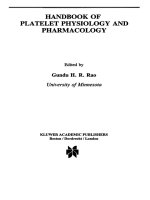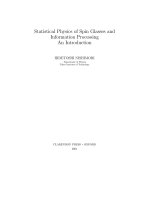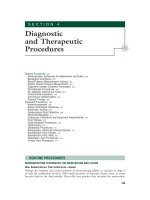handbook of ceramics glasses and diamonds
Bạn đang xem bản rút gọn của tài liệu. Xem và tải ngay bản đầy đủ của tài liệu tại đây (6.24 MB, 806 trang )
HANDBOOK
OF CERAMICS,
GLASSES,
AND DIAMONDS
HANDBOOK
OF CERAMICS,
GLASSES,
AND DIAMONDS
Charles A. Harper Editor-in-Chief
Technology Seminars, Inc., Lutherville, Maryland
McGRAW-HILL
New York Chicago San Francisco Lisbon London
Madrid Mexico City Milan New Delhi San Juan
Seoul Singapore Sydney Toronto
Copyright © 2001 by The McGraw-Hill Companies, Inc. All rights reserved. Manufactured in the
United States of America. Except as permitted under the United States Copyright Act of 1976, no part
of this publication may be reproduced or distributed in any form or by any means, or stored in a data-
base or retrieval system, without the prior written permission of the publisher.
0-07-141467-3
The material in this eBook also appears in the print version of this title: 0-07-026712-X.
All trademarks are trademarks of their respective owners. Rather than put a trademark symbol after
every occurrence of a trademarked name, we use names in an editorial fashion only, and to the benefit
of the trademark owner, with no intention of infringement of the trademark. Where such designations
appear in this book, they have been printed with initial caps.
McGraw-Hill eBooks are available at special quantity discounts to use as premiums and sales pro-
motions, or for use in corporate training programs. For more information, please contact George
Hoare, Special Sales, at or (212) 904-4069.
TERMS OF USE
This is a copyrighted work and The McGraw-Hill Companies, Inc. (“McGraw-Hill”) and its licensors
reserve all rights in and to the work. Use of this work is subject to these terms. Except as permitted
under the Copyright Act of 1976 and the right to store and retrieve one copy of the work, you may not
decompile, disassemble, reverse engineer, reproduce, modify, create derivative works based upon,
transmit, distribute, disseminate, sell, publish or sublicense the work or any part of it without
McGraw-Hill’s prior consent. You may use the work for your own noncommercial and personal use;
any other use of the work is strictly prohibited. Your right to use the work may be terminated if you
fail to comply with these terms.
THE WORK IS PROVIDED “AS IS”. McGRAW-HILL AND ITS LICENSORS MAKE NO GUAR-
ANTEES OR WARRANTIES AS TO THE ACCURACY, ADEQUACY OR COMPLETENESS OF
OR RESULTS TO BE OBTAINED FROM USING THE WORK, INCLUDING ANY INFORMA-
TION THAT CAN BE ACCESSED THROUGH THE WORK VIA HYPERLINK OR OTHERWISE,
AND EXPRESSLY DISCLAIM ANY WARRANTY, EXPRESS OR IMPLIED, INCLUDING BUT
NOT LIMITED TO IMPLIED WARRANTIES OF MERCHANTABILITY OR FITNESS FOR A
PARTICULAR PURPOSE. McGraw-Hill and its licensors do not warrant or guarantee that the func-
tions contained in the work will meet your requirements or that its operation will be uninterrupted or
error free. Neither McGraw-Hill nor its licensors shall be liable to you or anyone else for any inac-
curacy, error or omission, regardless of cause, in the work or for any damages resulting therefrom.
McGraw-Hill has no responsibility for the content of any information accessed through the work.
Under no circumstances shall McGraw-Hill and/or its licensors be liable for any indirect, incidental,
special, punitive, consequential or similar damages that result from the use of or inability to use the
work, even if any of them has been advised of the possibility of such damages. This limitation of lia-
bility shall apply to any claim or cause whatsoever whether such claim or cause arises in contract, tort
or otherwise.
DOI: 10.1036/0071414673
abc
McGraw-Hill
CONTENTS
Preface
xiii
Contributors
xv
Chapter 1. Ceramic Materials and Properties
1.1
1.1 Introduction 1.1
1.1.1 Definitions of Tabulated Properties 1.1
1.2 Classes of Materials Covered 1.9
1.2.1 Rocks and Minerals 1.11
1.2.2 Vitreous Ceramics 1.11
1.2.3 Refractory Groups (Oxides, Nitrides, Carbides, and Borides) 1.13
1.2.4 Concrete 1.33
1.2.5 Glasses 1.36
1.2.6 Diamond 1.36
1.3 Summary 1.42
References 1.42
Chapter 2. Ceramics, Glasses, and Micas for Electrical Products 2.1
2.1 Introduction 2.1
2.2 Electrical Tests and Measurements 2.5
2.2.1 Resistivity 2.5
2.2.2 Dielectric Constant 2.5
2.2.3 Microwave Properties 2.5
2.2.4 Dielectric Strength 2.5
2.2.5 Magnetic Properties 2.6
2.2.6 Piezoelectric Properties 2.6
2.3 Insulators 2.6
2.3.1 Ceramics 2.6
2.3.2 Glass 2.33
2.3.3 Mica 2.44
2.3.4 Ceramic and Glass Substrates 2.48
2.3.5 Glass-Ceramics 2.53
2.3.6 Seals 2.55
2.3.7 Thick-Film Components 2.67
References 2.69
Chapter 3. Electronic Ceramics 3.1
3.1 Properties of Electronic Materials 3.1
3.1.1 Electrical Conductivity 3.3
3.1.2 Thermal Expansion 3.5
3.1.3 Thermal Conductivity 3.6
v
Copyright 2001 McGraw-Hill Companies, Inc. Click Here for Terms of Use.
For more information about this title, click here.
3.2 Dielectric Insulators 3.9
3.2.1 Oxides 3.9
3.2.2 Nitrides and Carbides 3.13
3.3 Electronic Packaging 3.14
3.3.1 Ceramic Packaging 3.15
3.4 Capacitors 3.29
3.4.1 Material Classification 3.35
3.5 Electromechanical Materials 3.45
3.5.1 Piezoelectrics 3.45
3.5.2 Ferroelectrics 3.46
3.5.3 Electrostrictors 3.49
3.5.4 Materials 3.52
3.5.5 Applications 3.56
3.6 Electrooptic Materials 3.61
3.6.1 Materials 3.68
3.6.2 Applications 3.70
3.7 Superconductor Ceramics 3.73
3.7.1 Materials 3.74
3.7.2 Applications of Superconductors 3.80
3.8 Magnetic Ceramics 3.84
3.8.1 Spinels 3.90
3.8.2 Garnets 3.99
3.8.3 Perovskites 3.100
3.8.4 Hexagonal Ferrites 3.100
3.8.5 Applications 3.102
References 3.102
Chapter 4. Advanced Ceramics and Composites
4.1
4.1 Introduction 4.1
4.1.1 Composites 4.2
4.2 Ceramic Fabrication 4.3
4.2.1 Manufacturing Process 4.3
4.3 Surface Properties of Ceramics 4.5
4.3.1 Surface Roughness 4.5
4.3.2 Camber 4.8
4.4 Thermal Properties of Ceramic Materials 4.8
4.4.1 Thermal Conductivity 4.8
4.4.2 Specific Heat 4.10
4.4.3 Temperature Coefficient of Expansion 4.12
4.5 Mechanical Properties of Ceramic Substrates 4.13
4.5.1 Modulus of Elasticity 4.13
4.5.2 Modulus of Rupture 4.14
4.5.3 Tensile and Compressive Strength 4.16
4.5.4 Hardness 4.17
4.5.5 Thermal Shock 4.17
4.6 Electrical Properties of Ceramics 4.18
4.6.1 Resistivity 4.19
4.6.2 Breakdown Voltage 4.20
4.6.3 Dielectric Properties 4.21
4.7 Metallization of Ceramic Substrates 4.23
4.7.1 Thick Film 4.23
4.7.2 Thin Film 4.28
4.7.3 Copper Metallization Technologies 4.31
4.8 Ceramic Materials 4.32
4.8.1 Aluminum Oxide 4.33
vi
HANDBOOK OF CERAMICS, GLASSES, AND DIAMONDS
4.8.2 Beryllium Oxide 4.33
4.8.3 Aluminum Nitride 4.33
4.8.4 Diamond 4.36
4.8.5 Boron Nitride 4.38
4.8.6 Silicon Carbide 4.39
4.9 Composite Materials 4.40
4.9.1 Organic-Organic Composites 4.41
4.9.2 Organic-Ceramic/Glass Composites 4.41
4.9.3 Ceramic-Ceramic Composites 4.42
4.9.4 Ceramics-Glass Composites 4.42
4.9.5 Metal-Ceramic Composites 4.44
References 4.46
Chapter 5. Inorganic Glasses—Structure, Composition and Properties 5.1
5.1 Fundamentals of the Glassy State 5.1
5.1.1 Definitions of Glass 5.1
5.1.2 Methods of Making Inorganic Glasses 5.2
5.1.3 The Volume-Temperature Diagram 5.2
5.2 Glass Formation 5.6
5.2.1 Structural Concepts of Glass Formation 5.6
5.2.2 Kinetic Considerations 5.9
5.2.3 Ranges of Glass Formation 5.10
5.3 The Microstructure of Glass 5.12
5.3.1 Phase Separation and Liquid Immiscibility 5.12
5.3.2 Controlled Crystallization of Glass 5.15
5.4 Atomic Arrangements in Glass 5.15
5.4.1 Structure of Silica Glass 5.15
5.4.2 Structure of Alkali Silicate Glass 5.18
5.4.3 Structure of Alkali-Alkaline Earth-Silicate Glass 5.19
5.4.4 Structure of Boric Oxide, Borate, and Borosilicate Glasses 5.19
5.4.5 Structure of Alkali Aluminosilicate Glasses 5.21
5.4.6 Structure of Phosphate Glasses 5.21
5.4.7 Structure of Lead and Zinc Silicate Glasses 5.22
5.5 Composition-Structure-Property Relationships 5.22
5.5.1 Presentation of Glass Formulas 5.22
5.5.2 Interdependence of Glass Composition, Structure, and Properties 5.23
5.6 Density and Molar Volume 5.24
5.6.1 Introduction 5.24
5.6.2 Measurement of Density 5.24
5.6.3 Dependence on Composition 5.25
5.7 Elastic Properties 5.25
5.7.1 Introduction 5.25
5.7.2 Methods of Measuring Elastic Moduli 5.28
5.7.3 Composition Dependence of Elastic Moduli 5.28
5.8 Microhardness of Glass 5.30
5.8.1 Introduction 5.30
5.8.2 Measurement of Microhardness 5.31
5.8.3 Composition Dependence 5.33
5.9 Viscosity of Glass 5.33
5.9.1 Introduction 5.33
5.9.2 Viscosity-Temperature Dependence 5.33
5.9.3 Measurement of Viscosity 5.34
5.9.4 Composition Dependence of Viscosity 5.36
5.9.5 Strong and Fragile Liquids 5.37
5.9.6 Non-Newtonian Viscosity 5.37
CONTENTS vii
5.10 Surface Energy 5.40
5.10.1 Introduction 5.40
5.10.2 Measurement of Surface Tension 5.41
5.10.3 Composition and Temperature Dependence 5.42
5.11 Thermal Expansion 5.43
5.11.1 Introduction and Definitions 5.43
5.11.2 Measurement of Thermal Expansion 5.44
5.11.3 Expansion Mismatch Consideration for Glass-to-Metal Seals 5.45
5.11.4 Temperature and Composition Dependence of Thermal Expansion Coefficient 5.47
5.11.5 Thermal Shock Resistance 5.49
5.12 Heat Capacity 5.51
5.13 Heat Transfer 5.52
5.14 Glass Transformation Range Behavior 5.54
5.14.1 Introduction 5.54
5.14.2 Measurement of Glass Transition Temperature T
g
and the Fictive Temperature T
f
5.55
5.14.3 Relaxation of Properties 5.55
5.15 Diffusion and Permeation 5.56
5.15.1 Introduction 5.56
5.15.2 Measurement of Diffusion 5.56
5.15.3 Temperature Dependence of Diffusion 5.57
5.15.4 Composition Dependence of Diffusion 5.57
5.15.5 Permeation 5.57
5.16 Electrical Conduction 5.60
5.16.1 Introduction 5.60
5.16.2 Temperature Dependence 5.61
5.16.3 Application of DC Potential Across Glass 5.61
5.16.4 Measurement of Electrical Conductivity 5.62
5.16.5 Composition Dependence 5.63
5.17 Dielectric Properties 5.66
5.18 Chemical Durability 5.68
5.18.1 Introduction 5.68
5.18.2 Measurement of Chemical Durability 5.69
5.18.3 Composition Dependence 5.69
5.18.4 Methods of Improving Chemical Durability 5.71
5.19 Mechanical Strength 5.71
5.19.1 Introduction 5.71
5.19.2 Slow Crack Growth 5.72
5.19.3 Toughness 5.72
5.19.4 Statistics of Strength Distribution 5.75
5.19.5 Life Prediction 5.75
5.19.6 Measurement of Glass Strength and Toughness 5.76
5.19.7 Methods of Improving Glass Strength 5.77
5.20 Optical Properties of Glass 5.77
5.20.1 Refraction and Dispersion 5.77
5.20.2 Reflection 5.78
5.20.3 Transmission and Absorption 5.79
5.20.4 Light Scattering Losses 5.85
5.20.5 Birefringence 5.88
5.20.6 Nonlinear Effects 5.89
5.20.7 Radiation Effects 5.90
5.20.8 Photosensitive Glasses 5.90
5.20.9 Measurement of Optical Properties 5.91
Bibliography 5.95
References 5.95
viii
HANDBOOK OF CERAMICS, GLASSES, AND DIAMONDS
Chapter 6. Inorganic Glasses—Commercial Glass Families,
Applications, and Manufacturing Methods
6.1
6.1 Commercial Glass Families 6.1
6.1.1 Introduction 6.1
6.1.2 Soft Glasses 6.3
6.1.3 Hard Glasses 6.23
6.1.4 Fused Silica and High-Silica Glasses 6.29
6.1.5 Borate Phosphate, Aluminate, and Germanate Glasses 6.30
6.1.6 Nonoxide Glasses 6.31
6.2 Special Glasses 6.32
6.2.1 Introduction 6.32
6.2.2 Sealing Glasses and Solder Glasses 6.32
6.2.3 Colored and Opal Glasses 6.32
6.2.4 Optical Glasses 6.39
6.2.5 Photochromic and Polarizing Glasses 6.45
6.2.6 Photosensitive Glass 6.47
6.2.7 Glass-Ceramics 6.47
6.2.8 Strengthened Glasses 6.56
6.2.9 High-Silica Glasses 6.58
6.3 Glass Making I—Glass Melting 6.67
6.3.1 Introduction and General Nature 6.67
6.3.2 Steps in Glass Melting 6.68
6.3.3 Types of Melters 6.75
6.4 Glass Making II—Glass Forming 6.82
6.4.1 Blowing 6.82
6.4.2 Pressing 6.83
6.4.3 Casting 6.85
6.4.4 Centrifugal Forming 6.85
6.4.5 Rod and Tube Drawing 6.87
6.4.6 Sheet Drawing 6.90
6.4.7 Rolling 6.92
6.4.8 The Float Process 6.92
6.4.9 Fritting 6.94
6.4.10 Spheres, Marbles, and Microspheres 6.94
6.5 Annealing and Tempering 6.96
6.5.1 Development of Permanent Stresses in Glass 6.96
6.5.2 Stress Profiles in a Symmetrically Cooled Glass
Plate during Annealing and Tempering 6.97
6.5.3 Standards of Annealing 6.99
6.5.4 Annealing Practices 6.100
6.5.5 Standards of Temper 6.101
6.5.6 Commercial Tempering Practices 6.103
6.5.7 Limitations of Thermal Tempering 6.105
6.5.8 Chemical Strengthening of Glass 6.105
6.5.9 Examination of Stresses in Glass 6.108
6.6 Glass Fiber 6.117
6.6.1 Discontinuous Fiberglass (Wool and Textile) 6.117
6.6.2 Continuous Fiberglass (Textile and Reinforcement) 6.124
6.6.3 Traditional Fiber Optics 6.128
6.7 Optical Communications Fiber 6.132
6.7.1 Introduction 6.132
6.7.2 Materials 6.132
6.7.3 Types of Optical Fiber Design 6.132
6.7.4 Manufacturing Processes 6.133
Notes 6.137
CONTENTS ix
Acknowledgments 6.138
References 6.138
Bibliography 6.138
Chapter 7. Advanced Applications of Glass
7. 1
7.1 Optical Waveguides in Communications 7.1
7.1.1 Waveguide Introduction and Fundamentals 7.2
7.1.2 Fiber and Waveguide Fabrication Techniques 7.11
7.1.3 Optical Amplification 7.14
7.1.4 Future Developments 7.18
7.2 Electronic Displays 7.19
7.2.1 Vacuum-Based Displays 7.19
7.2.2 Solid-State Displays 7.24
References 7.31
Chapter 8. Ceramics and Glasses in Microelectronics 8.1
8.1 Introduction 8.1
8.2 Thick-Film Conductors 8.1
8.2.1 Background 8.1
8.2.2 Basic Constituents 8.3
8.2.3 Inorganic Binders 8.15
8.2.4 Microstructure Development 8.19
8.2.5 Conductor Properties and Test Methods 8.23
8.2.6 Structure-Property Relations 8.32
8.3 Thick-Film Dielectrics 8.37
8.3.1 Introduction 8.37
8.3.2 Dielectric Compositions 8.38
8.3.3 Thick-Film Capacitor Dielectrics 8.44
8.3.4 Microstructure Development 8.45
8.3.5 Dielectric Properties 8.48
8.3.6 Property Measurements 8.60
8.3.7 Effects of Processing Conditions on Dielectric Properties 8.63
8.4 Resistor Materials and Processing 8.64
8.4.1 Introduction 8.64
8.4.2 Background 8.65
8.4.3 General Requirements 8.66
8.4.4 Resistor Compositions 8.70
8.4.5 Resistor Properties 8.79
8.4.6 Effects of Variables on Electrical Properties 8.85
8.4.7 Conduction Mechanisms 8.91
8.4.8 Laser Trimming 8.94
8.4.9 Overglazing of Resistors 8.97
8.5 Rheology and the Screen Printing Process 8.97
8.5.1 Introduction 8.97
8.5.2 Viscosity 8.98
8.5.3 Classification of Rheology Behavior 8.98
8.5.4 Measurement Instruments 8.102
8.5.5 Measurement Methods 8.104
8.5.6 Interparticle Forces 8.106
8.5.7 Suspension Structure 8.109
8.5.8 Effects of Paste Formulation on Paste Rheology 8.112
8.5.9 Rheology and Thick-Film Screen Printing Correlation 8.118
8.5.10 Wetting and Screen Print Resolution 8.122
x
HANDBOOK OF CERAMICS, GLASSES, AND DIAMONDS
8.5.11 Leveling of the Printed Part 8.123
8.5.12 Via Retention and Line Resolution 8.124
8.5.13 Examples of Paste Rheology Printing Performance 8.126
8.6 Quality Control and Manufacturing Processes 8.129
8.6.1 Raw Material and Paste Characterization 8.129
8.6.2 Paste Production and Characterization 8.131
8.6.3 Screen Printing 8.131
8.6.4 Drying 8.131
8.6.5 Firing 8.132
8.7 Nonhybrid Applications 8.132
References 8.134
Chapter 9. Industrial Diamond 9.1
9.1 Introduction and Historical Overview 9.1
9.2 Mesh Diamond 9.3
9.2.1 Properties and Characterization 9.4
9.2.2 Bond Systems and Tool Fabrication 9.9
9.2.3 Applications 9.11
9.3 Cubic Boron Nitride (cBN) 9.15
9.3.1 Properties 9.16
9.3.2 Bond Systems 9.17
9.3.3 Applications 9.17
9.4 Polycrystalline Diamond and cBN 9.19
9.4.1 Properties 9.20
9.4.2 Processing and Tool Fabrication 9.21
9.4.3 Application and Use Guidelines 9.22
9.5 Micron Diamond and cBN 9.25
9.5.1 Characterization 9.26
9.5.2 Applications 9.27
Acknowledgments 9.28
References 9.29
Appendix A.1
Index I.1
CONTENTS xi
PREFACE
An understanding of materials and their processing and final properties, while not
always fully appreciated, is absolutely critical to the design and manufacture of prod-
ucts and to their performance and reliability. Although this has always been
fundamentally true, the demands of modern high-technology products frequently make
materials the critical limiting factor not only for success in today’s products but also for
success in achieving the next generation. This is, of course, a constant and continuing
goal. Areview of recent publications will show that modern materials technology has been
well addressed for some groups of materials but not for ceramics, glasses, and diamonds.
It is, therefore, the object of this handbook to present, in a single source, all the funda-
mental information required to understand the large number of materials and material
forms, and to provide the necessary data and guidelines for optimal use of these mate-
rials and forms in the broad range of industry products. At the same time, this handbook
will be invaluable to industry in acquainting its specialists with product requirements
for which they must develop, manufacture, and fabricate materials and forms made with
ceramics, glasses, and diamonds.
Acompanion to my other series handbooks, namely, Handbook of Materials for Product
Design, Modern Plastics Handbook, and Handbook of Plastics, Elastomers, and
Composites, this Handbook of Ceramics, Glasses, and Diamonds has been prepared as a
thorough sourcebook of practical data for all ranges of interests. It contains an extensive
array of property and performance data, presented as a function of the most important prod-
uct variables. Further, it presents all important aspects of application guidelines,
fabrication-method trade-offs, design, finishing, performance limits, and other important
application considerations. It also fully covers chemical, structural, and other basic mate-
rial properties. The handbook’s other major features include an extensive appendix of
material properties and suppliers, a thorough and easy-to-use index, and very useful end-
of-chapter reference lists.
The chapter organization and coverage of the handbook is equally well suited for reader
convenience. The first four chapters are devoted to ceramics, the following three to glasses,
and then one chapter devoted to the important roles of ceramics and glasses in microelec-
tronics, and a final chapter devoted to industrial diamonds. In both the ceramic and glass
set of chapters, and also in the diamond chapter, the materials presented cover all areas of
the subject, including fundamentals, material properties and applications, processes, and
the like. As such, they are oriented to have subjects useful for all areas of interest, from
research and development to processing, product design, application, and other specialist
areas. Materials covered range from general purpose to advanced high-performance prod-
uct applications.
As will be evident by a review of the subject and author listings, I have had the good
fortune to be able to bring together a team of outstanding chapter authors, each with a great
depth of experience in his or her field. Together, they offer the reader a base of knowledge
as perhaps no other group could. Hence, I would like to give special credit to these authors
in this preface. Also, I would like to give special credit to Ceramic Industry Magazine, and
xiii
Copyright 2001 McGraw-Hill Companies, Inc. Click Here for Terms of Use.
Editor Christine Grahl for the material presented in the appendix. This is indeed an excel-
lent addition to this Handbook of Ceramics, Glasses and Diamonds.
Reader comments will be welcomed and appreciated.
Charles A. Harper
Technology Seminars, Inc.
Lutherville, Maryland
xiv HANDBOOK OF CERAMICS, GLASSES, AND DIAMONDS
CONTRIBUTORS
Alex E. Bailey American Technical Ceramics, Jacksonville, Florida (CHAP
. 3)
Venkata Bhagavatula Corning Inc., Corning, New York (
CHAP
. 7)
Mark P. D’Evelyn General Electric Company, Schenectady, New York (
CHAP. 9)
Frances Fehlner Consultant, Corning, New York (
CHAP. 7)
Christine Grahl Ceramic Industry Magazine, Columbus, Ohio (
APPENDIX)
Dana L. Hankey Technology Business Development, Albuquerque, New Mexico (CHAP. 8)
Chandra S. Khadilkar Electronic Materials Division, Ferro Corporation, Vista, California (
CHAP
. 8)
Jerry E. Sergent TCA, Inc., Williamsburg, Kentucky (
CHAP. 4)
Thomas P. Seward III Alfred University, Alfred, New York (CHAPS. 5, 6)
Aziz S. Shaikh Electronics Materials Division, Ferro Corporation, Vista, California (
CHAP. 8)
Allen B.Timberlake Consultant, Columbia, Maryland (
CHAP. 1)
Arun Varshneya Alfred University, Alfred, New York (CHAPS. 5, 6)
S.Vasudevan Electronics Materials Division, Ferro Corporation, Vista, California (
CHAP
. 8)
xv
Copyright 2001 McGraw-Hill Companies, Inc. Click Here for Terms of Use.
ABOUT THE EDITOR
Charles A. Harper is President of Technology Seminars, Inc., a Lutherville, Maryland, orga-
nization that provides educational training courses in materials and electronics for industry,
government, and other professional groups. Previously, he was Manager of Materials and
Electronic Packaging Technologies for Westinghouse Electric Corporation in Baltimore,
Maryland. Mr. Harper is also Series Editor for the McGraw-Hill Materials Science and
Engineering Series, as well as the McGraw-Hill Electronic Packaging and Interconnection
Series. He is a Fellow of the Society for the Advancement of Materials and Process
Engineering (SAMPE) and is Past President and Fellow of the International Microelectronics
and Packaging Society (IMAPS). He is a graduate of the Johns Hopkins University,
Baltimore, Maryland, where he also served as Adjunct Professor. Mr. Harper is widely rec-
ognized for his teaching, writing, and editorial activities, and for his leadership role in major
professional societies.
Copyright 2001 McGraw-Hill Companies, Inc. Click Here for Terms of Use.
CHAPTER 1
CERAMIC MATERIALS AND
PROPERTIES
Allen B.Timberlake
Consultant
1.1 INTRODUCTION
The numerous branches of ceramics technology are frequently classified as either tradi-
tional or advanced. Traditional ceramics usually include the older technologies, such as
brick, china, concrete, and whiteware. Advanced ceramics, also called fine ceramics by
Saito
1
and Norton,
2
are generally those where various methods are used to enhance the
properties—to make them harder, stronger, or more chemical resistant, for example.
Emphasis in this chapter is given to advanced ceramics.
This chapter is intended to provide a convenient compilation of many properties of the
materials discussed in other chapters of the book. Properties of interest to workers using
ceramics in structural as well as in electronic applications are listed. Several works have
been used extensively, including Harrison and Moratis,
3
Mattox,
4
Schwartz,
5
Buchanan,
6
and Saito.
1
In addition, industrial sources including Coors Ceramics, Kyocera, DuPont
Electronics, and Norton Diamond Film have been used.
1.1.1 Definitions of Tabulated Properties
1.1.1.1 Units and Conversion Factors.
7
The properties tabulated in this chapter are
defined in this section. The units of measure used in the tables are those used in the article
from which the data were taken, unless otherwise indicated. Since workers in the various
branches of ceramics technology use different systems of units in their publications—e.g.,
cgs metric, mks metric, International (S.I.), English, or U.S. Conventional—Table 1.1 lists
and defines the units of the International System. Table 1.2 provides factors for converting
among the various systems.
7
In cases where it seems desirable to convert data found in a
source from one system to another for consistency in a table, the converted data will be
placed in brackets, { }. The properties are grouped according to whether they are mechan-
ical, thermal, or electrical.
1.1
Copyright 2001 McGraw-Hill Companies, Inc. Click Here for Terms of Use.
1.2 CHAPTER ONE
TABLE 1.1 Derived Units of the International System (SI)
Unit symbol
(if different from Unit in terms of
Quantity Name of unit basic form) base units
Area square meter m
2
Volume cubic meter m
3
Density kilogram per cubic kg/m
3
meter
Force newton N kg ⋅ m/s
2
Pressure newton per square N/m
2
, Pa kg/(m ⋅ s
2
)
meter, pascal
Power, heat flux watt, joule per second W, J/s kg ⋅ m
2
/s
3
Heat capacity joule per kilogram J/(kg ⋅ K) m
2
/(s
2
⋅ K)
per kelvin
Thermal watt per meter per W/(m ⋅ K), kg ⋅ m/(s
3
⋅ K)
conductivity kelvin, joule-meter J ⋅ m (s ⋅ m
2
⋅ K)
per second per square
meter per kelvin
TABLE 1.2 Factors for Converting SI Units to U.S. Customary or English Units
To convert To convert
U.S./English SI to English English to SI,
Quantity SI unit unit multiply by: multiply by:
Area square square foot, ft
2
10.76391 0.09200304
meter, m
2
Volume cubic meter, m
3
cubic foot, ft
3
35.31467 2.831685 × 10
−2
Mass kilogram, kg pound, lb 2.204623 0.4535924
Density kilogram per pound per cubic 0.06242795 16.01847
cubic meter, foot, lb/ft
3
kg ⋅ m
−
3
Force newton, N pound force, lbf 0.2248089 4.448222
Energy joule, J British thermal 9.478172 × 10
−4
1055.056
unit, Btu
Energy kilowatt-hour, British thermal 3412.142 2.930711 × 10
−4
kwh unit, Btu
Pressure Pascal, Pa pound per square 1.450377 × 10
−4
6894.757
inch, lb/in
2
Power, heat watt, joule Btu per hour, 0.2939711 3.9016949
flux per second Btu/h
Heat joule per Btu per pound per 2.389 × 10
−4
4.1868 × 10
3
capacity kilogram per Fahrenheit
kelvin degree
Thermal watt per meter Btu-foot per hour 0.5777892 1.730735
conductivity per kelvin, per square foot per
W/m · K Fahrenheit degree,
Btuft/(h · ft
2
· F°)
Table 1.3 lists many ASTM methods of measurement for the properties of most inter-
est to users of ceramics.
1.1.1.2 Mechanical Properties
Density. The mass per unit volume of a material is its density. The term is often used
synonymously with specific gravity, a unitless quantity that is the ratio of the density of the
material to the density of pure water at 4°C. The two quantities are numerically identical
in the SI system, but are quite different in the English system.
Elastic Modulus or Young’s Modulus. When a rod of length l and cross-sectional
area A is subjected to a tensile force F, the rod will undergo an increase in length ∆l accord-
ing to the formula
(1.1)
where E is a property of the material known as Young’s modulus. Young’s modulus, then,
is the relationship of stress to strain, i.e., the fractional change in dimension caused by an
applied force. Young’s modulus can also be determined by measuring the bending of a rod
by a force applied to the midpoint of the rod supported at both ends.
Shear or Rigidity Modulus. When successive layers of material are moved or
sheared by tangential surface force or a torsional force, the magnitude of strain is deter-
mined by the shear modulus or modulus of rigidity. The angular strain,
θ
radians, induced
in a rod of radius r, length l, by a torque C is given by
(1.2)
where M is the modulus of rigidity of the material.
θ π
= 2
4
Cl r M/
CERAMIC MATERIALS AND PROPERTIES 1.3
TABLE 1.3 ASTM Property Test Methods
ASTM
Properties test methods
Physical
Specific gravity C-329, C-20
Porosity C-373
Flexure strength C-674
Hardness C-730, E-18
Fracture toughness
Thermal
Expansion coefficient F-228, C-359
Thermal conductivity C-408, C-177
Shock resistance D-116
Electrical
Dielectric constant D-2149, D-150,
and dissipation D-2520
factor
Dielectric strength D-149
Electrical resistivity D-257, D-1829
∆lFlAE= /
Brittleness. The propensity of a material to chip or fracture during manufacture or
handling is known as its brittleness. Although brittleness is not frequently quantified, a brit-
tleness index, BI, has been defined by Lawn and Marshall,
8
as follows:
(1.3)
where H is the hardness and K
c
is the toughness.
Fracture Toughness. The fracture toughness, K
lc
, is a measure of a ceramic part’s
resistance to fracture. For a given part it is highly dependent on the treatment the part has
experienced. Voids, inclusions, surface flaws, scratches, cracks, and other flaws seriously
degrade a ceramic part’s fracture toughness. Tables of fracture toughness should include a
description of how the part was treated prior to testing—e.g., as-fired, polished, or etched—
since the fracture toughness is significantly affected by such treatments. Fracture toughness
is determined by measuring the force required to fracture a test specimen of prescribed
shape in a test fixture designed for this purpose.
A frequently used fixture is shown in Fig. 1.1.
9
A test specimen is supported at the ends,
and a load is imposed, equally divided on two probes placed near the center of the piece,
as shown. The load is increased until the specimen fractures. Fracture toughness is calcu-
lated from the following formula
10
:
(1.4)
KaF
lc c
=
σπ ζ
()()
BI = HK
c
/
1.4 CHAPTER ONE
FIGURE 1.1 Schematic of flexural strength test for ceramics: (a) Three-
point bend, (b) three-point loading, three-point bend, and (c) quarter-point
loading, four-point bend.
where K
lc
= fracture toughness
σ
c
= bend strength
a = flaw size
F(ζ) = constant determined by the shape of the specimen
Ceramic specimens will fail over a range of applied stresses depending on the density
and types of flaws and defects as described above. In order to gain a reliable measure of
the fracture toughness of a material, it is necessary to test a large number of specimens. The
failures will usually follow a distribution function F, known as the Weibull function, shown
in Eq. (1.5):
(1.5)
The three parameters m,
σ
, and
σ
0
are constants for the material; m is the Weibull modu-
lus and
σ
µ
is the maximum value of stress under which the specimen will not fail, which
is usually set to zero. Rearranging, setting
σ
equal to
σ
max
, the largest value of stress in the
specimen, setting the integral term to V
E
, the effective volume, and taking logarithms of
both sides reveals
(1.6)
A log-log plot of failure probability versus stress will have a slope of m, the Weibull
modulus. Figure 1.2 shows the failure distributions of silicon carbide and silicon nitride at
room and elevated temperatures.
A large value of m indicates that the all samples of the material fail over a narrow range
of applied stresses. Therefore the stress required to cause failure is more predictable than
it would be if the failures occurred over a wide range of applied stresses, as would be
indicated by a low value of m. Saito has published several plots for specimens prepared
differently, e.g., ground with different mesh abrasives, which demonstrate the sensitivity
of this parameter to surface preparation. Schwartz
5
compiled data over a period of years
showing how Weibull modulus and mean tensile strength depend on sample preparation.
Hardness. The resistance to indentation or deformation of a material is known as its
hardness. There are many hardness scales and methods of measurement. Most methods
involve indenting a test specimen by impressing a weighted diamond stylus of a prescribed
shape on it, and measuring the area or depth of the indentation. The ratio of applied force
to area of indention is defined as the hardness. The scales used most frequently for ceramic
materials are Mohs, Vickers, Brinnell, Rockwell, and Knoop. These are discussed here.
1. Mohs hardness. For ceramic materials and minerals, which are harder than most other
materials, the Mohs scale was one of the earliest measures of hardness. The Mohs
scale calls for scratching the specimen with a succession of materials, with each suc-
ceeding scratch material being harder than the one that preceded it.
11
The order of the
scratch material that cannot make a discernible scratch is called the Mohs hardness
of the specimen.
Initially 10 scratch materials were used, ranging from talc at the soft end to diamond
at the hard end. The scale was later expanded to 15, with five materials added between
the original numbers 9 and 10, corundum and diamond. All are listed in Table 1.4.
11
Although the Mohs scale has the advantages of simplicity and ease of use, it also has
ln / ( ) ln ln( / )
max
11
0
−= −Fm V
m
E
σσ
FdV
V
m
=− − −
∫
1
0
exp [( ) / ]
σσ σ
µ
CERAMIC MATERIALS AND PROPERTIES 1.5
several disadvantages. It is qualitative; it is not linear, in that the differences between
adjacent numbers on the scale are not equal; and it does not give a value that can be
expressed in terms of other physical quantities, such as force. For these reasons other
methods for measuring and scaling hardness were developed.
2. Brinnel hardness. An indentation is made by a 10-mm-diameter hardened steel or sin-
tered tungsten carbide ball. A load of 500 kgf is used for soft metals, and 3000 kgf for
hard metals. Brinnell hardness is equal to the load in kilograms divided by the surface
area in square millimeters of the impression made in the test material.
3. Vickers hardness. The indenter is a square-based diamond pyramid with included angle
between faces of 136°. Loads of different magnitudes are used, with 10, 30, and 50 kgf in
common use. The indenter makes a square indentation in the test material. Vickers hard-
ness is defined as the load in kilograms divided by the area in square millimeters of the
indentation. The area of indentation is calculated from the lengths of the diagonals.
4. Knoop hardness. A Knoop indenter is impressed on a specimen, and the depth of pen-
etration determines the Knoop hardness. The Knoop indenter is a diamond pyramid with
a rhombic base. The diagonals are in the ratio of 1:7, and included apical angles are 130°
and 172° 30′.
1.6 CHAPTER ONE
FIGURE 1.2 Weibull distribution shows spread in fracture strengths of ceramics. (From Ref. 1.)
5. Rockwell hardness. Again, the hardness value is determined by measuring the size of
an indentation caused by a point impressed on the sample under a prescribed load. The
indenter can be either a -, -, or -inch-diameter steel ball or conical diamond having
an apex angle of 120° and a slightly rounded tip. Letters, with the letter indicating both
the indenter and the weight of the load, designate the various scales.
Modulus of Rupture. Ordinary stress-strain testing is not generally used to test
ceramic substrates since they do not exhibit elastic behavior to a great degree. An alterna-
tive test, the modulus of rupture (bend strength) test, as described in Fig. 1.1, is preferred.
Asample of ceramic, either circular or rectangular, is suspended between two points, a force
is applied in the center, and the elongation of the sample is measured. The stress is calcu-
lated by
(1.7)
where
σ
= stress in megapascals (MPa)
M = maximum bending moment in N · m
x = distance from center to outer surface in m
I = moment of inertia in N ⋅ m
2
= xy
3
/12 for rectangular cross section
=
π
R
2
/4 for circular cross section
For a sample of length l, M can be shown to be Fl/4, where F is the applied force in new-
tons. When expressions for
σ
, M, x, and I are inserted into Eq. (1.7), the results are:
(1.8)
for rectangular cross section, and
(1.9)
for circular cross section.
σπ
= Fl r/
3
σ
= 32
2
Fl xy/
σ
= Mx I/
1
4
1
8
1
16
CERAMIC MATERIALS AND PROPERTIES 1.7
TABLE 1.4 Comparison of Hardness Values of Various Ceramics on Knoop, Mohs, and
Expanded Mohs Scales
Hardness Ridgeway’s extension Knoop hardness of
number Mohs’ scale of Mohs’ scale expanded scale materials
1 Talc Talc
2 Gypsum Gypsum 32
3 Calcite Calcite 135
4 Fluorite Fluorite 163
5 Apatite Apatite 430
6 Orthoclase Orthoclase 560
7 Quartz Vitreous silica —
8 Topaz Quartz or stellite 820
9 Corundum Topaz 1340
10 Diamond Garnet 1360
11 Fused zirconia —
12 Fused alumina 2100
13 Silicon carbide 2480
14 Boron carbide 2750
15 Diamond 7000









